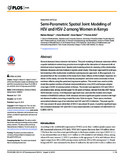Semi-Parametric Spatial Joint Modeling of HIV and HSV-2 among Women in Kenya

View/
Date
2015-08Author
Okango, Elphas L.
Mwambi, Henry
Ngesa, Oscar
Achia, Thomas
Metadata
Show full item recordAbstract
Several diseases have common risk factors. The joint modeling of disease outcomes within a spatial statistical context may provide more insight on the interaction of diseases both at individual and at regional level. Spatial joint modeling allows for studying of the relationship between diseases and also between regions under study. One major approach for joint spatial modeling is the multivariate conditional autoregressive approach. In this approach, it is assumed that all the covariates in the study have linear effects on the multiple response variables. In this study, we relax this linearity assumption and allow some covariates to have nonlinear effects using the penalized regression splines. This model was used to jointly model the spatial variation of human immunodeficiency virus (HIV) and herpes simplex virus-type 2 (HSV-2) among women in Kenya. The model was applied to HIV and HSV-2 prevalence data among women aged 15–49 years in Kenya, derived from the 2007 Kenya AIDS indicator survey. A full Bayesian approach was used and the models were implemented in WinBUGS software. Both diseases showed significant spatial variation with highest disease burdens occurring around the Lake Victoria region. There was a nonlinear association between age of an individual and HIV and HSV-2 infection. The peak age for HIV was around 30 years while that of HSV-2 was about 40 years. A positive significant spatial correlation between HIV and HSV-2 was observed with a correlation of 0.6831(95% CI: 0.3859, 0.871).
URI
http://journals.plos.org/plosone/article?id=10.1371/journal.pone.0135212http://hdl.handle.net/123456789/3020
https://doi.org/10.1371/journal.pone.0135212
Collections
- Journal Articles (PAS) [289]
